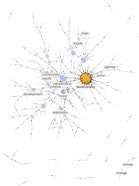Seeing the shape of biodiversity governance—evidence from 718 pledges
News
Publish date: October 28, 2025

Seeing the shape of biodiversity governance—evidence from 718 pledges
News
Publish date: October 28, 2025
A new open-access study maps 718 biodiversity pledges to show how ideas and influence move across scales, where links are missing, and why a “middle-out” space matters for turning global ambition into local action. Authored and led by Van Thi Hai Nguyen, Postdoctoral researcher on Biodiversity Governance and Policy at Wyss Academy with co-authors Truc-Ly Le-Huynh, Simon Gadola, Quynh Nguyen, Gretchen Walters, and Margaret Awuor Owuor, working across the Wyss Academy for Nature and the University of Bern (Institute of Ecology and Evolution; Institute of Political Science), the University of Lausanne, and the University of Virginia—the study appeared in Environmental Science & Policy in October 2025. It asks a straightforward question with complex implications: how does global ambition turn into local action?
The team examined 718 public pledges logged under the Convention on Biological Diversity’s Action Agenda for Nature. Each pledge was reviewed by hand to record who made it, who they partnered with, what they intend to change, and where. Read as a network—1,086 actors linked by 4,109 connections—this dataset shows structure rather than a list: clusters that work closely together, bridges that carry ideas between groups, and gaps where coordination falters.
One pattern stands out. Much of the connective work runs through a “middle-out” space—local NGOs, city and regional authorities, research groups, alliances, and businesses. These actors translate international goals into practical work and, when linked well, carry grounded insights upward. At the same time, ties to national biodiversity strategies, or National Biodiversity Strategies and Action Plans, are thin, which weakens the vertical pathway between local efforts and national targets.

Set against this, the current policy moment gives the findings added relevance. Countries are now moving from promises to practice under the Kunming–Montreal Global Biodiversity Framework (KMGBF), the global plan adopted in 2022 to halt and reverse biodiversity loss by 2030. The map points to where momentum can be built: strengthening middle-out connections and stitching them more tightly to national planning, so efforts add up across levels.
These signals also resonate with work already underway at the Wyss Academy: long-term collaborations in diverse places, attention to how decisions are made, and a steady flow of grounded evidence into the arenas where policy is shaped. Emphasis on the middle-out space points to practical routes for carrying tested approaches beyond pilot sites and into national processes over time.
The map is a snapshot and will evolve, but it clarifies where governance already connects and where small, well-placed links could unlock larger change. If those links are built, grounded efforts are more likely to add up to national progress and, ultimately, to global outcomes.